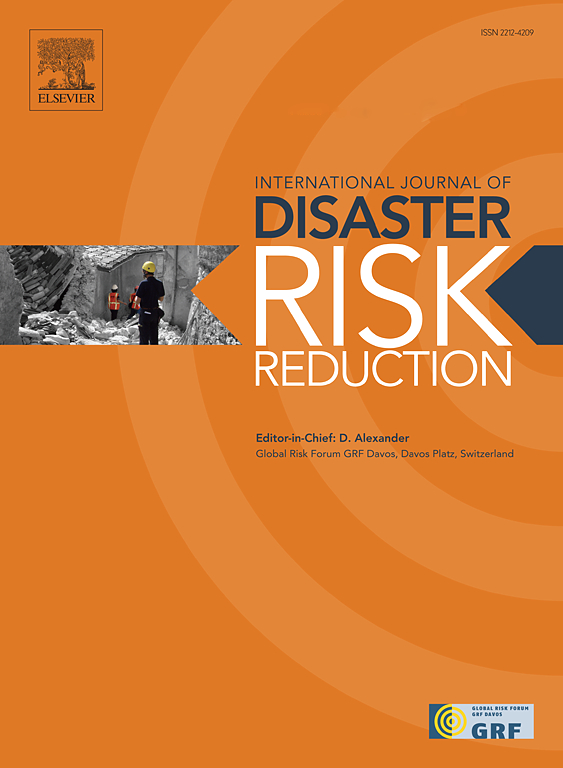Exploring residents’ expectations and designers’ perspectives towards post-earthquake permanent housing: A case study in Antakya
IF 4.2
1区 地球科学
Q1 GEOSCIENCES, MULTIDISCIPLINARY
International journal of disaster risk reduction
Pub Date : 2024-10-01
DOI:10.1016/j.ijdrr.2024.104873
引用次数: 0
Abstract
Post-disaster permanent housing is the backbone of the recovery efforts after destructive events. It holds great potential to adopt new technological innovations and to provide improved conditions for these everyday spaces. However, previous investigations suggest that these housing projects lack consideration of the inhabitants' expectations, needs, and values due to environmental, cultural, and social factors, resulting in a dissatisfactory built environment. Following the Kahramanmaraş earthquake on February 6, 2023, this research aims to explore the expectations of affected residents in the historic district of Antakya. We expect to contribute to decision-makers, designers, and the technology industry to develop more user-centered housing recovery efforts in the aftermath of these devastating events. The findings revealed four implications from the expectations for post-earthquake homes: (1) designing for togetherness, (2) valuing community efforts and traditional work, (3) including productional activities, and lastly, (4) preserving and reminiscing heritage values. Additionally, we discussed these four implications with multi-disciplinary designers to expand the discussion space for designing post-earthquake permanent homes in Antakya. Overall, these implications suggest some future architectural changes in homes as their residents' expectations, including the creation of new heritage and production spaces using digital, physical, and mixed reality technologies, as well as the emergence of new social gathering spaces. By conducting a case study in Antakya, our research highlights the potential for the further development of post-disaster permanent homes that not only provide shelter and safety but also enhance the overall quality of life for the residents, both for Antakya and the other relevant cases worldwide.
探索居民对震后永久性住房的期望和设计师的观点:安塔基亚案例研究
灾后永久性住房是破坏性事件后恢复工作的支柱。它在采用新技术创新和为这些日常空间提供更好的条件方面具有巨大潜力。然而,以往的调查表明,由于环境、文化和社会因素,这些住房项目缺乏对居民期望、需求和价值观的考虑,导致建筑环境不尽人意。2023 年 2 月 6 日发生卡赫拉曼马拉什地震后,本研究旨在探讨安塔基亚历史街区受影响居民的期望。我们希望能为决策者、设计师和技术行业做出贡献,在这些破坏性事件发生后,开发出更多以用户为中心的住房恢复工作。研究结果揭示了对震后住宅期望的四点影响:(1) 为团结而设计,(2) 重视社区努力和传统工作,(3) 包括生产活动,最后,(4) 保护和缅怀遗产价值。此外,我们还与多学科设计师讨论了这四点启示,以拓展安塔基亚震后永久性住宅设计的讨论空间。总之,这些影响表明,未来的住宅建筑将按照居民的期望发生一些变化,包括利用数字、物理和混合现实技术创造新的遗产和生产空间,以及出现新的社交聚会空间。通过在安塔基亚开展案例研究,我们的研究强调了进一步开发灾后永久性住宅的潜力,这些住宅不仅能提供庇护所和安全,还能提高居民的整体生活质量,无论是在安塔基亚还是在全球其他相关案例中都是如此。
本文章由计算机程序翻译,如有差异,请以英文原文为准。
求助全文
约1分钟内获得全文
求助全文
来源期刊

International journal of disaster risk reduction
GEOSCIENCES, MULTIDISCIPLINARYMETEOROLOGY-METEOROLOGY & ATMOSPHERIC SCIENCES
CiteScore
8.70
自引率
18.00%
发文量
688
审稿时长
79 days
期刊介绍:
The International Journal of Disaster Risk Reduction (IJDRR) is the journal for researchers, policymakers and practitioners across diverse disciplines: earth sciences and their implications; environmental sciences; engineering; urban studies; geography; and the social sciences. IJDRR publishes fundamental and applied research, critical reviews, policy papers and case studies with a particular focus on multi-disciplinary research that aims to reduce the impact of natural, technological, social and intentional disasters. IJDRR stimulates exchange of ideas and knowledge transfer on disaster research, mitigation, adaptation, prevention and risk reduction at all geographical scales: local, national and international.
Key topics:-
-multifaceted disaster and cascading disasters
-the development of disaster risk reduction strategies and techniques
-discussion and development of effective warning and educational systems for risk management at all levels
-disasters associated with climate change
-vulnerability analysis and vulnerability trends
-emerging risks
-resilience against disasters.
The journal particularly encourages papers that approach risk from a multi-disciplinary perspective.
 求助内容:
求助内容: 应助结果提醒方式:
应助结果提醒方式:


